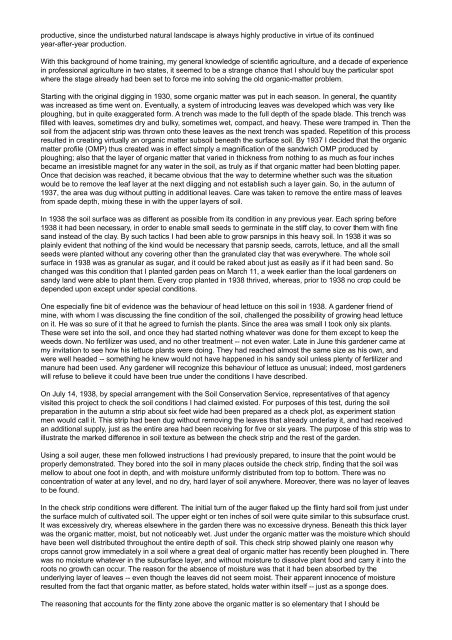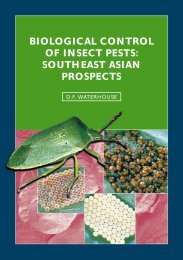Ploughman's Folly Ploughman's Folly - EcoPort
Ploughman's Folly Ploughman's Folly - EcoPort
Ploughman's Folly Ploughman's Folly - EcoPort
Create successful ePaper yourself
Turn your PDF publications into a flip-book with our unique Google optimized e-Paper software.
productive, since the undisturbed natural landscape is always highly productive in virtue of its continued<br />
year-after-year production.<br />
With this background of home training, my general knowledge of scientific agriculture, and a decade of experience<br />
in professional agriculture in two states, it seemed to be a strange chance that I should buy the particular spot<br />
where the stage already had been set to force me into solving the old organic-matter problem.<br />
Starting with the original digging in 1930, some organic matter was put in each season. In general, the quantity<br />
was increased as time went on. Eventually, a system of introducing leaves was developed which was very like<br />
ploughing, but in quite exaggerated form. A trench was made to the full depth of the spade blade. This trench was<br />
filled with leaves, sometimes dry and bulky, sometimes wet, compact, and heavy. These were tramped in. Then the<br />
soil from the adjacent strip was thrown onto these leaves as the next trench was spaded. Repetition of this process<br />
resulted in creating virtually an organic matter subsoil beneath the surface soil. By 1937 I decided that the organic<br />
matter profile (OMP) thus created was in effect simply a magnification of the sandwich OMP produced by<br />
ploughing; also that the layer of organic matter that varied in thickness from nothing to as much as four inches<br />
became an irresistible magnet for any water in the soil, as truly as if that organic matter had been blotting paper.<br />
Once that decision was reached, it became obvious that the way to determine whether such was the situation<br />
would be to remove the leaf layer at the next diigging and not establish such a layer gain. So, in the autumn of<br />
1937, the area was dug without putting in additional leaves. Care was taken to remove the entire mass of leaves<br />
from spade depth, mixing these in with the upper layers of soil.<br />
In 1938 the soil surface was as different as possible from its condition in any previous year. Each spring before<br />
1938 it had been necessary, in order to enable small seeds to germinate in the stiff clay, to cover them with fine<br />
sand instead of the clay. By such tactics I had been able to grow parsnips in this heavy soil. In 1938 it was so<br />
plainly evident that nothing of the kind would be necessary that parsnip seeds, carrots, lettuce, and all the small<br />
seeds were planted without any covering other than the granulated clay that was everywhere. The whole soil<br />
surface in 1938 was as granular as sugar, and it could be raked about just as easily as if it had been sand. So<br />
changed was this condition that I planted garden peas on March 11, a week earlier than the local gardeners on<br />
sandy land were able to plant them. Every crop planted in 1938 thrived, whereas, prior to 1938 no crop could be<br />
depended upon except under special conditions.<br />
One especially fine bit of evidence was the behaviour of head lettuce on this soil in 1938. A gardener friend of<br />
mine, with whom I was discussing the fine condition of the soil, challenged the possibility of growing head lettuce<br />
on it. He was so sure of it that he agreed to furnish the plants. Since the area was small I took only six plants.<br />
These were set into the soil, and once they had started nothing whatever was done for them except to keep the<br />
weeds down. No fertilizer was used, and no other treatment -- not even water. Late in June this gardener came at<br />
my invitation to see how his lettuce plants were doing. They had reached almost the same size as his own, and<br />
were well headed -- something he knew would not have happened in his sandy soil unless plenty of fertilizer and<br />
manure had been used. Any gardener will recognize this behaviour of lettuce as unusual; indeed, most gardeners<br />
will refuse to believe it could have been true under the conditions I have described.<br />
On July 14, 1938, by special arrangement with the Soil Conservation Service, representatives of that agency<br />
visited this project to check the soil conditions I had claimed existed. For purposes of this test, during the soil<br />
preparation in the autumn a strip about six feet wide had been prepared as a check plot, as experiment station<br />
men would call it. This strip had been dug without removing the leaves that already underlay it, and had received<br />
an additional supply, just as the entire area had been receiving for five or six years. The purpose of this strip was to<br />
illustrate the marked difference in soil texture as between the check strip and the rest of the garden.<br />
Using a soil auger, these men followed instructions I had previously prepared, to insure that the point would be<br />
properly demonstrated. They bored into the soil in many places outside the check strip, finding that the soil was<br />
mellow to about one foot in depth, and with moisture uniformly distributed from top to bottom. There was no<br />
concentration of water at any level, and no dry, hard layer of soil anywhere. Moreover, there was no layer of leaves<br />
to be found.<br />
In the check strip conditions were different. The initial turn of the auger flaked up the flinty hard soil from just under<br />
the surface mulch of cultivated soil. The upper eight or ten inches of soil were quite similar to this subsurface crust.<br />
It was excessively dry, whereas elsewhere in the garden there was no excessive dryness. Beneath this thick layer<br />
was the organic matter, moist, but not noticeably wet. Just under the organic matter was the moisture which should<br />
have been well distributed throughout the entire depth of soil. This check strip showed plainly one reason why<br />
crops cannot grow immediately in a soil where a great deal of organic matter has recently been ploughed in. There<br />
was no moisture whatever in the subsurface layer, and without moisture to dissolve plant food and carry it into the<br />
roots no growth can occur. The reason for the absence of moisture was that it had been absorbed by the<br />
underlying layer of leaves -- even though the leaves did not seem moist. Their apparent innocence of moisture<br />
resulted from the fact that organic matter, as before stated, holds water within itself -- just as a sponge does.<br />
The reasoning that accounts for the flinty zone above the organic matter is so elementary that I should be






